#ancient levant
Explore tagged Tumblr posts
Text
Jehovah, Jehovah, Jehovah!... No, actually, it's Yahweh,
A somewhat notable Deity considered by the ancient Israelite people their National God and first attested from the early 9th century BCE.¹

This c. 1518 painting by Raphael is based on a mystical vision of 𒀭Yahweh attributed to the prophet Ezekiel who belonged to a priestly lineage said to be descended from the legendary Joshua. Ezekiel was active during the time the Kingdom of Judah was conquered by the Neo-Babylonian Empire in the early 6th century BCE. (Public domain)
𒀭Yahweh was also apparently worshipped among the Edomites, the Israelites' southern neighbors, based on a reference to “Yahweh of Teman” in an inscription on an early 8th century BCE jar discovered at the site of Kuntillet ʿAjrud in the Sinai with Teman being a major Edomite clan.¹ It's believed the ʿAjrud outpost was established by the northern Kingdom of Israel as the region fell into their domain after a botched invasion by the southern Kingdom of Judah. The two kingdoms were also under the influence of the Neo-Assyrian Empire at this time with contemporaneous Assyrian records noting both Judahite and northern Israelite representatives at the capital city of Kalkhu (known as Nimrud in modern times).²


Illustrations of the two vessels from Kuntillet ʿAjrud with translations. It's debated if the 𒀭Bes-type figures on Pithos A are meant to depict 𒀭Yahweh and His Consort 𒀭ʾAsheratah, but it should be noted the righthand figure does not actually have visible genitals as the outdated illustration here shows.³ (Source)
Although 𒀭Yahweh is primarily associated with monotheistic religion nowadays for obvious reasons, historical evidence indicates He was first worshipped in a polytheistic context as the Israelite culture distinguished itself from the Canaanite milieu it emerged from. This can even be seen within the Hebrew Bible; A wonderful example is found in the Book of Habakkuk in the form of an archaic Hebrew poem describing 𒀭Yahweh and His Company including the Plague-God 𒀭Resheph (His Name is usually mistranslated as “plague” in English Bibles) battling sea monsters. Another one of the most noted can be seen in the Book of Deuteronomy and indicates 𒀭Yahweh was probably worshipped as One of the Seventy (symbolically “many”) Sons of 𒀭ʾEl:
⁸ When ʿElyon apportioned the nations, when He divided humankind, He fixed the boundaries of the peoples according to the number of the Gods; ⁹ Yahweh's own portion was His people, Jacob His allotted share.
Deuteronomy 32:8–9 (adapted from the New Revised Standard Version, Updated Edition, 2021)
𒀭Yahweh very much fits the form of other Storm-Gods worshipped in cultures of the Syro-Palestinian region during the Iron Age. The other most famous example of such a Deity is the Levantine manifestation of 𒀭Baʿal Who is cast as 𒀭Yahweh's greatest Rival in the collection of texts within the Hebrew Bible known as the Deuteronomistic history, although the presence of 𒀭Baʿal's name at ʿAjrud would suggest this conflict is a later development. It's even been proposed 𒀭Yahweh was originally associated specifically with destructive elements of weather such as flash floods.⁴ Although there are some respectable academic claims of pre-Israelite attestations of 𒀭Yahweh from the Late Bronze Age, none of these are secure and all of them are very much contested.⁵ The scholar Christian Frevel also fascinatingly proposed in 2021 that 𒀭Yahweh was the tutelary Deity of the Omride clan which came to rule the northern Kingdom of Israel for over a century and established its capital of Samaria.¹

A modern artistic impression of a ritual performed by ancient Israelites at the Temple of 𒀭Yahweh in Jerusalem during the Iron Age. The dedication of the Temple in Jerusalem built by King Solomon (c. 1910) by William Hole. (Public domain)
The emergence of monotheism from traditional Israelite belief is an incredibly convoluted topic that I don't intend to get into the weeds of here. One of the most recognizable milestones therein, though, was the religious reforms of King Josiah of Judah shortly before our dear Ezekiel's time. This saw the absolute consolidation of religious authority in the Temple of 𒀭Yahweh at Jerusalem and even the forced closure of all other cultic sites in Judah. However, there's also direct evidence that 𒀭Yahweh continued to be worshipped among other Gods and Goddesses well after the monotheistic, Jerusalem-centric religion which came to be known as Judaism had entered its Second Temple Period.
Most notably a community of Israelites living on the island of Elephantine at ancient Egypt's southern frontier had a Pantheon in which 𒀭Yahweh was associated with the Goddess 𒀭ʿAnat and another God named 𒀭Bethel.⁶ They even had Priestesses of Yahweh and were apparently on good terms with Jerusalem as indicated by the Aramaic-language texts written in Egyptian Demotic script discovered at Elephantine. An analysis of the narrative of Aaron's Rod in the Book of Numbers has also led to the alluring proposition that worship of the famous 𒀭ʾAsherah as 𒀭Yahweh's Consort may have continued even within the Jerusalemite cult itself during this period.⁷

An altar of incense discovered at the site of ancient Ta'anakh. Although it's dated to the tenth century BCE, predating any secure attestations of 𒀭Yahweh, some researchers believe the top and second-to-bottom registers are intended to symbolize Him with 𒀭ʾAsheratah likewise on the alternating registers. (Source)
There's so many fascinating developments being made in archaeology and the study of history unraveling more about the ancient Israelites and the worship of 𒀭Yahweh before our very eyes. I honestly feel incredibly privileged to be alive just in time to witness such a thing. Although I haven't “worked with” 𒀭Yahweh myself within my primarily Canaanite Pagan practice, I'd be very interested to hear and discuss different perspectives on this fascinating ancient Deity and it'd make me very happy to see what some of you think. Shulmu 𒁲𒈬 and thank you so much for reading!
Another thing
Given what part of the world this all concerns, I feel I would be morally remiss to say nothing of the genocide taking place against the Palestinian people in their homeland and particularly in Gaza. I find this important because earlier today the so-called President of the United States Donald Trump expressed the US's intent to “take over” and ethnically cleanse Gaza at a public event alongside Benjamin Netanyahu, the so-called Prime Minister of Israel. In the face of such great evil, I feel obligated by simple virtue of being a human to state I wholeheartedly support the full liberation of Palestine and an end to the unjust and unlawful occupation with all it has wrought. Arab.org is a website which allows you to support Palestinians via a simple click of a button with no donation necessary along with providing further resources. Free Palestine 🇵🇸
References
Frevel, Christian. “When and from Where Did YHWH Emerge? Some Reflections on Early Yahwism in Israel and Judah.” Entangled Religions 12:2 (March 30, 2021). https://doi.org/10.46586/er.12.2021.8776.
Na’aman, Nadav. “Samaria and Judah in an Early 8th-Century Assyrian Wine List.” Tel Aviv 46:1 (January 2, 2019): pp. 12–20. https://www.academia.edu/43169801.
This was clarified by archaeologist Ze'ev Meshel in communication with Nir Hasson reporting for Haaretz, https://www.facebook.com/share/1JASsUsdcN.
Fleming, Daniel E. “Yahweh among the Baals: Israel and the Storm Gods.” Essay. In Mighty Baal: Essays in Honor of Mark S. Smith, edited by Stephen C. Russel and Esther J. Hamori, pp. 160–74. Harvard Semitic Studies 66. Leiden, Netherlands; Boston, Massachusetts, United States: Brill, 2020.
Pfeiffer, Henrik. “The Origin of YHWH and its Attestation.” Essay. In The Origins of Yahwism, edited by Markus Witte and Jürgen van Oorschot, pp. 115–44. Beihefte Zur Zeitschrift Für Die Alttestamentliche Wissenschaft 484. Berlin, Germany; Boston, Massachusetts, United States: De Gruyter, 2017.
Cornell, Colin. “Judeans and Goddesses at Elephantine.” Ancient Near East Today 7:11 (November 2019). American Society of Overseas Research (ASOR). https://www.asor.org/anetoday/2019/11/Judeans-and-Goddesses-at-Elephantine.
Eichler, Raanan. “Aaron’s Flowering Staff: A Priestly Asherah?” TheTorah.com, 2019. https://www.thetorah.com/article/aarons-flowering-staff-a-priestly-asherah.

My interpretation of the Blessing of ʾAmaryaw inscribed on Pithos B from Kuntillet ʿAjrud (pictured)
Be in peace!
May you be blessed to 𒀭Yahweh of Teman and 𒀭ʾAsheratah;
May they bless you and keep you and be with you always.
Praises to 𒀭Yahweh of Teman and 𒀭ʾAsheratah!
All they beseech of one is to act with compassion,
And 𒀭Yahu will give them according to their heart.
May the days be long and satisfied in their good time
For the sake of 𒀭Yahweh of Teman and 𒀭ʾAsheratah,
As 𒀭Yahweh of Teman and 𒀭ʾAsheratah favor the kindhearted.
#ancient history#ancient near east#history#pagan#paganism#semitic pagan#semitic paganism#ancient levant#baal#bronze age#iron age#canaanite pagan#canaanite paganism#canaanite#canaanite polytheism#yahweh#yhwh#el#asherah#anat#resheph#canaan#israelites#israelite#ancient israelite#ancient religion#ancient egypt#elephantine#polytheist#polytheism
65 notes
·
View notes
Text
Fascinating discovery.
7 notes
·
View notes
Text
Why Pork Became Taboo

By kallerna - Own work, CC BY-SA 4.0, https://commons.wikimedia.org/w/index.php?curid=110364613
The archaeological record shows that pigs were domesticated in the Near East from wild boar more than 11,400 years ago, though they were herded in a semi-wild fashion until much more recently, allowing interbreeding with wild boar even after domestication. They were separately domesticated in China 8,000 years ago from wild boar local to the area, making them genetically distinct from the ones found in Europe and the Near East. Pork is about 1/3 of all meat eaten world wide, yet two billion people hold beliefs that explicitly prohibit pork consumption. Researchers have been trying to find a reason for this and when it began within the archaeological record.

Source: https://archaeology.org/issues/march-april-2025/letters-from/on-the-origin-of-the-pork-taboo/
From about 3500-1200 BCE, in the earliest cities, people in the Levant were 'enthusiastic pig eaters', which continued through the 'occasional pork feast' in Jerusalem through 586 BCE. Researchers are trying to find out why pork consumption became scarce before the taboos were enacted.
Pigs reproduction far outstrips cows, goats, and sheep, with a single sow able to produce up to 100 piglets in her lifetime and these reaching maturity in about 6 months. They require half the water of cows and are able to convert trash into meat. This likely led to them being one in five animals eaten in Anatolia about 10,000 BCE based on bone remains, early in their domestication when they were still more closely related to boars than modern pigs. The archaeological record shows that domesticated pigs spread more slowly than sheep and goats, which were domesticated at roughly the same time, though they thrived in areas with forests and water, allowing them to forage as well as cleaning up food waste that might attract pests, thus limiting the spread of disease.

Source: https://archaeology.org/issues/march-april-2025/letters-from/on-the-origin-of-the-pork-taboo/
Neolithic sites show that people held pork barbecues, likely as a way to increase social cohesion as well as feeding people. There are also graves with pigs and people together, showing they were important beyond their utility as food and waste management. As the Bronze Age began, pork became the most widely consumed meat in Mesopotamia, with pigs adapting well to living within the cities. These cities provided protection, stagnant water, shade, and waste for the pigs to eat. Despite their prevalence in the archaeological record, pigs don't show up in the written records of the time. This is likely because herds of cows, sheep, and goats were easier for the government to oversee compared to pigs that roamed the city, could be kept in smaller pens, and reproduced and grew rapidly.
This likely also indicated that pigs were more likely used by the poor of the cities for food, as well. Those that held money and power preferred to eat beef or mutton. Cows and sheep were also far easier to tax because they lived in herds outside the city and reproduced more slowly, which meant they could be readily observed. The Hittites began replacing pigs in religious rituals, which led to a change across the region of the Near East. By 1600 BCE, pork consumption was down to about 5% in the Levant and nearly ceased by 1100 BCE.

Source: https://archaeology.org/issues/march-april-2025/letters-from/on-the-origin-of-the-pork-taboo/
The elimination of pork from the religious and dietary lives of the Levant doesn't seem to be the result of a sudden taboo, nor disease or environmental change. Researchers think the decline was the result of more frequent droughts and deforestation of the areas as well as an increase of trade in wool and milk products. Pigs began to be 'seen as scavengers with an insatiable appetites for food and sex' rather than a source of nutrition, especially for the poor.
Most scholars date the Tanak, which contains the warning that the pig 'is impure to you; from their flesh, you shall not eat, and their carcasses you shall not touch', to about 600-300 BCE. This likely ties to the pastoral way of life that centered around sheep and goats, which didn't lend itself to the raising of pigs. Pigs were still prevalent along the Mediterranean coast in the more settled cities of the Philistines, who might have been among those who arrived with the Sea Peoples. Despite raising pigs, the Philistines seem to have eaten them only accounted for about 20% of the animals that they ate in the cities about 1200 BCE, and less than 1% in the more rural towns. This was nearly eliminated by the 10th century BCE, though.
From about 1000 BCE to 568 BCE, however, this trend reversed and pork consumption became more prevalent, though only accounted for about 8% of meat consumed in the northern kingdom of Israel and about 2% in the southern kingdom of Judah. In Jerusalem, a seven-month-old pig was found in the collapsed home of a wealthy family, showing that pork consumption wasn't limited to the poor at this time.
While there have been several theories put forward to explain the taboo, such as not raising animals suited to the highland pastures or to the dry climate, or to limit the spread of trichinosis (a parasite that causes diarrhea, vomiting, and fever and can lurk in under cooked meat), researchers think the reason lies in the fact that pigs are unlike the animals that the pastoral Israelites raised, namely that it 'has hooves and does not chew cud'.

Source: https://archaeology.org/issues/march-april-2025/letters-from/on-the-origin-of-the-pork-taboo/
Another researcher pointed out that the taboo gained a special status only after the invasion of Alexander the Great in 332 BCE since the Greeks ate much more pork than the Judeans did. This was also around the time when Judaism was fully codified in the 2nd century BCE. This taboo was probably further cemented as a way of separating Judeans from others after the Greeks fell to the Romans, who enjoyed pork even more than the Greeks did. The pig was also considered a symbol of the 'corruption, greed, oppression, and violence' associated with Rome.
4 notes
·
View notes
Text

Not significantly so, no, it wasn't. Lebanon was Lebanon. Even the Bible references it as it's own place. In the ancient Hebrew the land that is now Lebanon was called..."Lebanon".
Lebanon has always been its own neighboring territory and its ancient borders are pretty damn close to its modern day borders.


Lmao they deleted it
18K notes
·
View notes
Text


beelzebub
1 note
·
View note
Text
Sculpture of weather god or warrior—Canaanite, 1300-1200 BCE

This Canaanite sculpture depicts either a smiting weather deity or a warrior.
26 notes
·
View notes
Text

"A Traitor! A Traitor to the Law! A Traitor to our forefathers! You hold the Sin of your parents and their parents before! Why should I let you into the Second Temple?"
"I have not come for you Pharisee, I came for that Star for it has shone above all, neither the Gods of the Nile nor the Djedi before me had seen such a sight.....I may not know who that is yet....but I will one Day I will...and so even if you don't let me in
*Loosen grip on Sica*
all roads lead to that Star"
~~~~~~~~~~~~~~~~~~~~~
Meet ⲡⲁϣⲟⲛϯ (Pašonti), a Nubian Traveler hailing and escaping from Philae Temple, he is in search of a phenomenon known as
"The Christening" that appeared in his dreams and the signs around him.
Serious, Knowledgeable and a man of his word with tinge bit of Silly and Kindness, he is accompanied by two companions and his trusty sparrowhawk "Jubal".
~~~~~~~~~~~~~~~~~~~~
I COMMISSIONED FROM an Instagram artist @ craftsquartch4
She is an excellent Artist with Wholesomeness on her side
This Character comes from historical Fantasy Idea I had taking place in 1st century AD Middle East, I have no title for it yet cause no idea whether I'll be turning this into a series or something.
#christian art#nubian character#original character#commisioned art#bible fandom#art#digital art#birblr#ocs#birds of tumblr#levant sparrowhawk#second temple period#historical fantasy#middle east#ancient egypt#israel#roman empire
51 notes
·
View notes
Text
Of Contracts Between Gods and Men
On the Aeorian Kinsey-Deicide scale I’m a solid 5 (near exclusively god-preserving) which may seem surprising to my many dear associates who want those fundamental truths of existence wrecked. Without digging in any further, let’s do some quick religious history review on the question: Do you owe anything to the gods and do they owe anything to you?
The answer is not as universal as many raised in the nigh inescapable miasma of Christian theology may think! Reciprocal (or even unilateral) responsibility in religion comes and goes across history and geography. The Norse Aesir, for example, created humans but don’t owe them nada and only rarely bothered messing with them. The Greek pantheon are significantly more touchy on the subject of their pride but a person could manage offering no prayers or sacrifices as long as they didn’t promise any prayers or sacrifices. Probably. Compare this to Mayan theology, wherein both gods and humans have significant co-responsibility in maintaining balance; with ritual and sacrifice key to the continued safety of the polity. Divine-mortal relationships can be classified as nondirectional, unidirectional, or bidirectional with various advantages and disadvantages to each model. Gods come in lots of shapes and the demands they make aren’t universal!
A phrase that will often come up in any divinity studies is “covenant”. Originally a translation of the Hebrew berith or Greek diatheke, and also present in Islam, the Bahai’i faith, and possibly historical Phoenician religious practices, covenant theology has metastasized in Christian scholarship to the point it was genuinely hard to research this piece while dodging blogs by guys named Richard. But, broadly, it’s the idea of making an explicit deal with power(s) greater than yourself where you both have sides of the bargain to uphold.
Contract law is not the solution to every problem on earth or in fiction, but when the issue is a large disparity in power and mutual fears of future adverse behavior…. to quote Kate Bush “I’d make a deal with (the) god(s).”
Vitally, compared to other bidirectional pacts in world religion, Exandria has some advantages. For one thing, they have a godeater they’re right now helping to suppress. As long as the gods remain behind the divine gate they need mortal champions to effect their will—but that only holds true as long as the Divine Gate stays up. And unfortunately the problem with a fence someone else has erected is that you don’t know if they’ve kept a key.
If I was mortality’s lawyer? I’d ask for a second layer to that divine hamsterball I’d ask for anything left of the godkilling spark to be kept by the temples of Vasselheim—if they can’t be trusted with it no one can. And I’d promise cooperation from people of a certain degree of civic responsibility, not coerced or threatened out, whole hearted. But terms and conditions may vary.
Anyway, I guess the thesis is that it’s a terrible sin to destroy something you can’t comprehend with no idea of what the outcome will be (and a lot of you don’t seem to get the inconceivable joy of having/knowing/being a god, even just in fiction) but you can bring any monstrosity to the negotiating table. Don’t kill your gods, unionize against them.
#cr spoilers#critical role#bells hells#cr meta#critical role spoilers#and again I should clarify that a bidirectional mutually responsible relationship isn’t exclusive to the ancient near east#the Mayans incans and Aztecs all have some degree of entwined duties between mortals and gods in their ritual practices#(and I’m sure other religious practices did too—I’m not ethnologist I only know the big twenty)#a sort of coresponsibility for the state of the heavens and of earth#with the incans sharing the permanent embodied godhood aspect that characterizes a lot of pacific islander faith#(with high status individuals Becoming the god upon ascension permanently mingling the realms of god and man)#the ancient levant and some parts of Iran just happen to have framed it as contract rather than mutually assured destruction#the diversity of ideas about what someone who is a person but bigger would be and act like across human civilization are fascinating!#it’s why I reject the idea that a plot about divinity has to follow any script—cultural conceptions of divinity don’t!
25 notes
·
View notes
Text
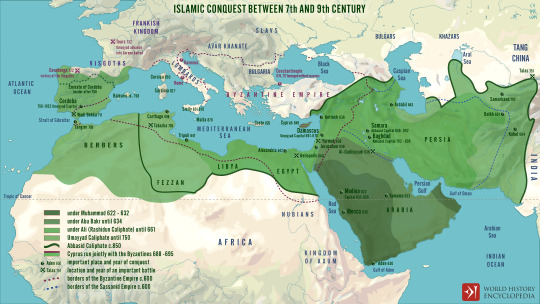
What made Arabisation so successful in the Levant and North Africa, whereas it failed in Iran, India, and the Caucasus?
Arabisation's success in the Levant and North Africa can be attributed to various historical, cultural, and geopolitical factors. The Arab invaders in these regions established centralized rule, which facilitated the spread of Arabic language and culture, I$|@m forced to them and played a crucial role as a unifying force, encouraging adoption of Arabic for religious purposes.
On the other hand, in regions like Iran, India, and the Caucasus, Arabisation faced challenges due to pre-existing rich and established civilizations with their own distinct languages and cultures, which was so much greater than arabs culture, In these areas, the local populations were more resistant to adopting Arabic, and their societies were not as readily assimilated into the Arab-dominated political structures.
in Iran, the Persian language had deep-rooted cultural significance, and Persian dynasties maintained their own identity and resisted Arabisation. In India, the vast and diverse society made it challenging for Arabic to become the dominant language. The Caucasus, with its diverse linguistic landscape and mountainous terrain, also hindered widespread Arabisation.

**Resistance and Nationalism**: In places like Iran, there was a strong sense of Persian identity and nationalism till today that resisted Arabisation. Persian language and culture have a long-standing and deeply rooted history that predates Abrahamic religions and the Arab conquests. The same applies to India, where there is a rich tapestry of local languages and cultures, and the Caucasus, where local nationalisms played a role in resisting Arabisation.
the success of Arabisation in the Levant and North Africa was facilitated by factors like centralized rule, religious influence, and a more receptive environment, whereas in Iran, India, and the Caucasus, the pre-existing cultural and linguistic diversity posed significant barriers to its adoption.
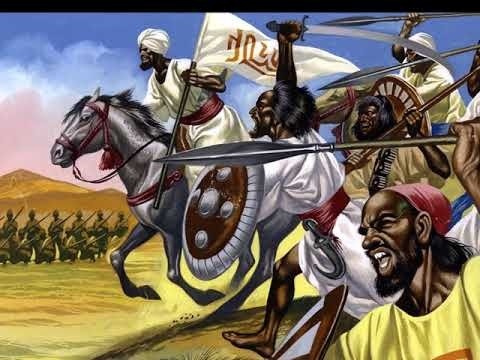

#kemetic dreams#islam#islamic jihad#colonization#north africa#levant#western asia#central asia#persian#brownskin#ancient persia#persistence#affirm and persist#persimmon#iran#india#bharat#critical role#african culture#asian culture#asians#asian conquest#brown skin#Arab
61 notes
·
View notes
Text
clé: levanter era is so underrated and it's quite insane to me because i think levanter is one of the best skz title tracks since they kinda did something different they didn't do previously but i do feel like it was one of their best songs in terms of vocals (lino falsetto we love you) BUT ALSO.... that album is so crazy?? and so important because it was delayed (if you know you know... if you were there you know what i mean) and so songs like you can stay and sunshine had such a big impact on the fandom back in the day especially sunshine it means a lot to me to this day and it's one the best skz bsides and i think about it all the time but the bside from this album that i think is criminally underrated is booster like booster is so good?? it's such a skz standard sound but it was so fresh at the time i remember being so obsessed with it when it came out and i was so mad nobody talk about her WHERE IS THE BOOSTER LOVE??? LIKE CMON GUYS but in general, that album an era are so significant in skz and stay history and it felt very much a gift to fans at that time it was pretty rough but i feel like getting these songs after everything went down was so worth it! it's genuinely one of my fav skz eras
#you honestly had to be there#i just started rambling mid post listen dkfjgdk#idk i like that album a lot#also this post came about bc i saw em's poll#and i voted levanter and i just got hit with nostalgia from that time#like i've been here guys dkfjgkd#i just have to remind everyone that i'm an ancient stay every now and then#anyways levanter is a such a good tt and that album too#SOMEONE HAD TO SAY IT !!!#tris.txt
49 notes
·
View notes
Text


Shulmu 𒁲𒈬, all. This is something I've been meaning to do for a while now, but I got to putting together this edition of the Shanatu Qadishti calendar, originally created by Tess Dawson based on the ancient Ugaritic ritual calendar, for this year and the next. As far as I can tell, this is the first time anything like this has been done in years, and it was rewarding if not somewhat frustrating.
Going by the ancient reckoning, a day of this calendar begins at Sunset on the Gregorian calendar day prior to the Shanatu Qadishti day's equivalent: So, for instance, Niqalu 0, 97 SQ, began at Sunset on September 1, 2024 CE, and ended at Sunset on Sep. 2, Niqalu 1 ran from the latter until Sunset on Sep. 3, Niqalu 2 from then until Sunset on Sep. 4, and so on. Chudthu and Mlatu days occur based on which sunset-to-sunset calendar day the corresponding lunar event falls in.
I've done my best to keep this faithful to Dawson's original scheme as to avoid confusion, but I actually did add one holiday of my own design: A Day of Lamentation for the Temple of 𒀭Baʿal-Shamin in ancient Tadmor/Palmyra, which was senselessly destroyed by ISIS terrorists on August 23, 2015 CE, followed shortly after by the Temple of 𒀭Bel at the same location. That day actually fell on the intercalary month of Shalamu per Dawson, and it wasn't possible to simply move it back a month as it would interrupt ʿAshuru Raʾshi Yeni, so I settled on Raʾshu Yeni 26 as a compromise. I'd hope such a day could be a valuable occasion for reflection and prayer, honoring victims of terrorism and intolerance.
Please note that this is a lunisolar calendar which operates based on lunation, and it's displayed here in accordance with the moon phases in my own locale. I've put the .XLSX files up in this Google Drive folder, so anyone can customize them to their utility with Google Sheets or Microsoft Excel. I used this website to figure the lunation out for myself, and it can be set to most any location (for instance, here it is set to the area of ancient Ugarit) with another tab for sunset times. Thanks for reading, I hope some of y'all find this useful!
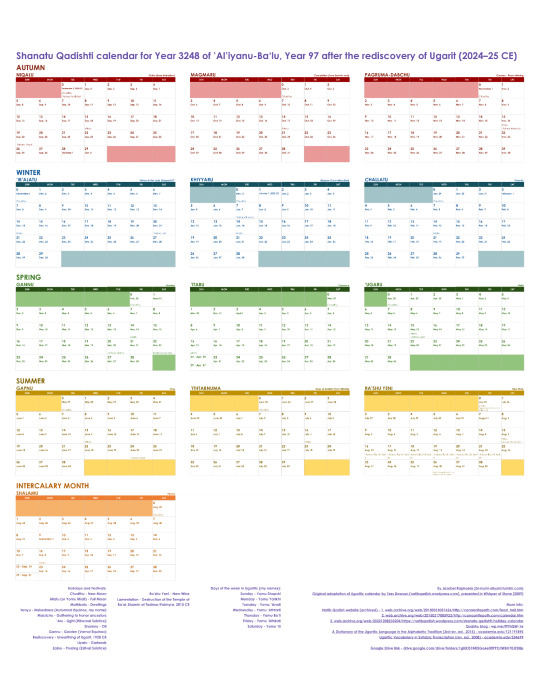
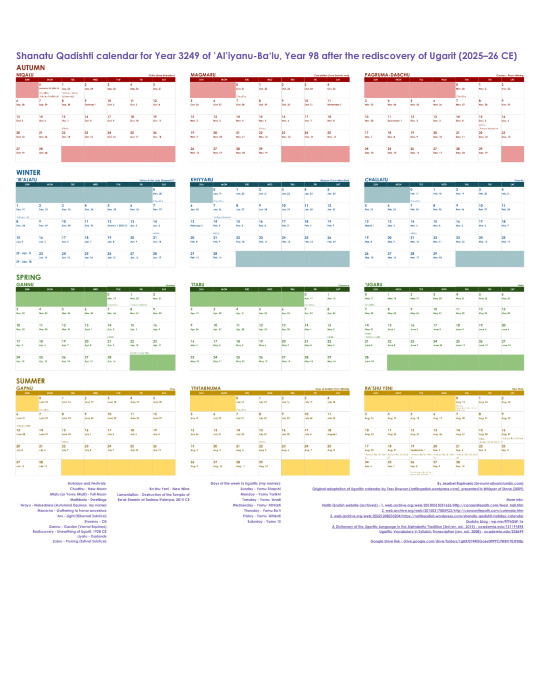
Here's the versions set to Ugarit's lunation if an "ecumenical" variation of the calendar would ever be necessary. I'd imagine for most, though, it'd be preferable to go off their own locale. Files are on the same Drive link as before '。˚⋆˙‧₊ .
#ancient near east#pagan#paganism#semitic pagan#semitic paganism#ancient levant#polytheism#polytheist#ugarit#ugaritic#ugaritic mythology#canaan#canaanite#canaanite pagan#canaanite paganism#canaanite polytheism#ritual calendar#baal#el#asherah#astarte#anat#shapash#yarikh#pagan festival#pagan holidays#lunar calendar#lunisolar calendar#festival#holiday
33 notes
·
View notes
Text

Glass alabastron (oil & perfume flask) from around the Eastern Mediterranean (Cyprus, Levant region & Egypt), Hellenistic, c. 100-01 B.C.
#eastern mediterranean#ancient mediterranean#alabastron#cyprus#egypt#levant#ancient egypt#hellenistic
23 notes
·
View notes
Text

Wadi Rabah Culture: this was the direct successor to the Lodian in and around Jericho, with the word 'wadi' meaning 'valley', so the cultural name could be translated as 'Raba' or the Rabah valley culture.
#history#historyfiles#archaeology#neolithic#neolithic farming#ancient world#fertile crescent#levant#jericho#lodian#wadi rabah
2 notes
·
View notes
Text
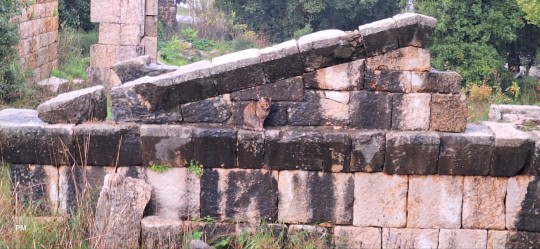
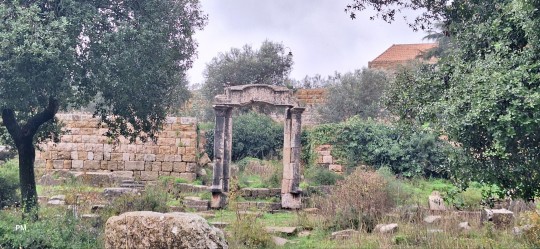
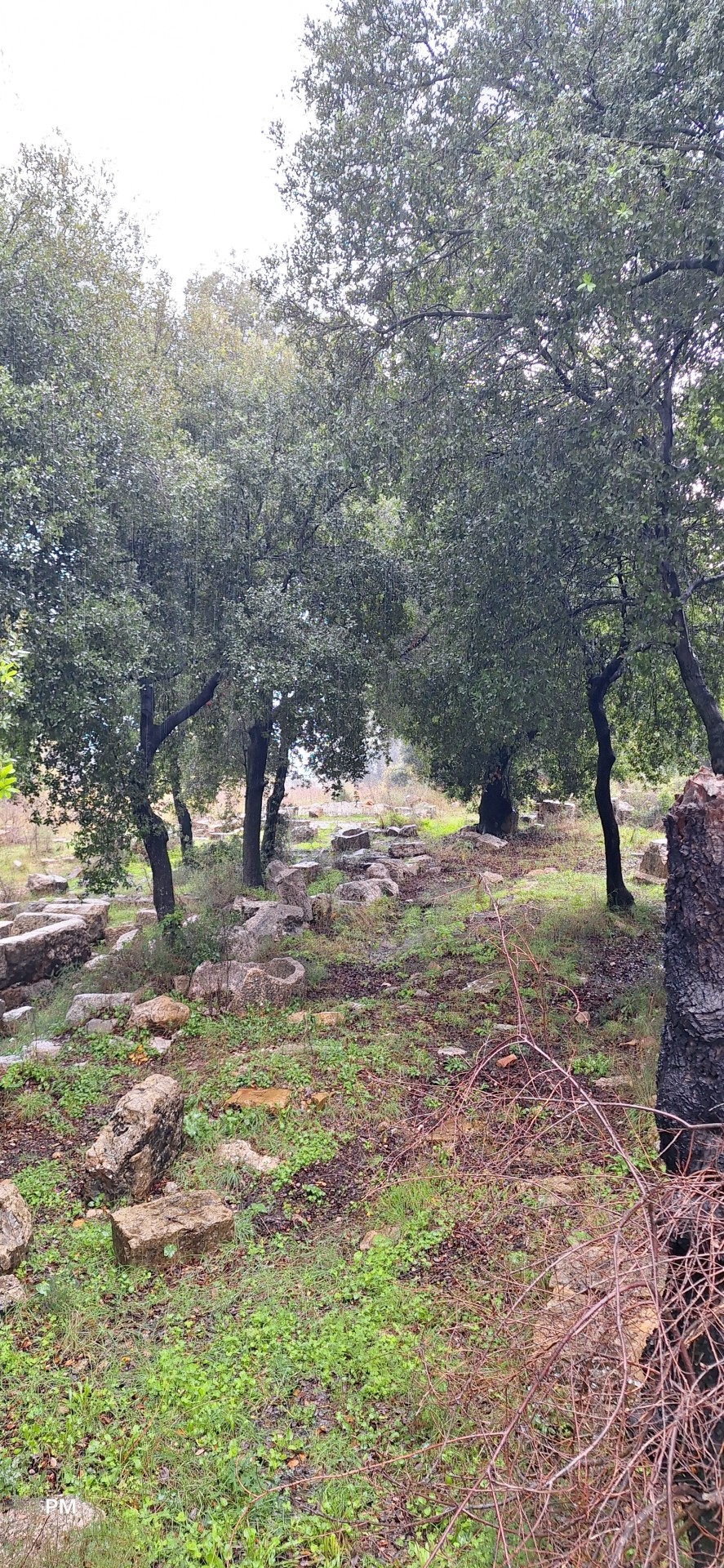
In the ruins of an old temple, a kitty hides from the winter rain.
7 notes
·
View notes
Text
7-cup offering bowl—Nahariya, Israel/Palestine, 17th century BCE

This offering bowl is currently in the Met's Collection.
#religious objects#ancient history#ancient art#jewish history#the exact culture this object was related to is not specified#levant#israel/palestine
12 notes
·
View notes
Text

“Mediterranean Without Borders” Sabine Réthoré, 2011 (French)
2 notes
·
View notes